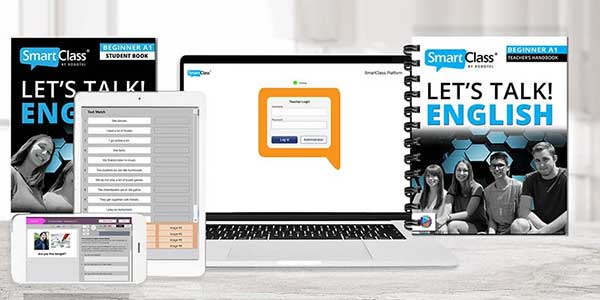ESL listening and speaking activities to try in your classroom
Even before COVID turned the world (of teaching) upside down, there was an abundance of teaching platforms out there. Some were specifically designed to support certain subject areas, others were kept general to help teachers survive in the new world of asynchronous teaching.
The problem with most platforms is that they aren't designed to prepare students for the multilingual world of the 21st century! Listening activities are hard to find in any of the language teaching materials, no matter what publisher or foreign language you are looking at. And speaking activities? Forget it! If I hadn't turned half of my writing activities into partner activities in the classroom, my students would have hardly had a chance to speak at all.
That's why SmartClass is such a game-changer. Not only are the activities fun, engaging, and authentic, but they also focus on all FOUR skills, with a heavy focus on speaking and listening. All activities (available in English, German, Arabic, and Spanish right now) are integrated into the SmartClass platform and ready to be assigned to students. Whether they are working on individual activities in the classroom, at home, or in a hybrid model, students are constantly challenged by listening to audio files or having to respond to questions and prompts in recordings that are submitted to the teacher for review. The AI-supported pronunciation activities are even automatically graded and provide instant feedback to students without needing teacher input or review.
Curious about how this works? Watch these short videos explaining some of the main recording and pronunciation functions in the SmartClass Teaching Platform, or read this post about all 19 different activity templates that are possible in the SmartClass Teaching Platform.
Open Recordings
Open Recording activities are valuable when you want to give your students a lot of time to talk freely about a topic. Their recording keeps going while they speak, think, correct themselves, or look at the visual/written prompts given. Some great examples for Open Recording activities are:
• Respond: Look at question(s) and respond
• Prompt: Respond to a prompt. (Weekly/Benchmark)
• Story: Look at the photographs and tell a story
• Pronunciation Paragraph Focus: Make paragraphs around certain phonetic sounds and have the students record
• Images: Look at individual pictures and say what each person is doing
• Translation: Have students listen to an audio or video in their native language and
translate into a foreign language (or vice-versa)
ESL Listening Activities: Segmented Recordings
The second speaking and listening template is Segmented Recording. You choose where the system adds pauses in a given audio file, so you don't have to leave pauses while you record the file.
It is also fantastic for audio files you might already have, such as songs, lectures, or files from other materials you are using. By clicking "variable-length responses" in the platform, you allow your students to take as much time as needed to answer the question after hearing an audio segment. Students then click on "DONE" to automatically move on to the next question/segment they listen to and respond to. Some examples of interactive and engaging segmented recording activities are:
• Question and Answer: Listen to a question and respond
• Listen and Repeat: Practice vocabulary and sentences (> 3-second segments!)
• Put all of your chapter vocabulary in an audio file to be repeated - easy homework activity
Continuous Recording
The third option for a speaking activity is Continuous Recording. For this type of activity, you need to build pauses into your audio file before uploading it. So it won't work with any audio files that might have come on a CD or you were able to download from the internet. Especially if you want it to be more of a listen/answer OR listen/repeat situation activity.
If you are recording your own audio/video file, though, it's a wonderful tool to replicate real-life situations even better. Just remember to leave enough time for students to respond or repeat and also build in a pause at the very end for the last question. The difference between a segmented and a continuous recording is that you decide how much time your students have to answer with a continuous recording. They can't choose when to move on to the next question, but as soon as their time is up, the following question/sentence will automatically be played, and they have to respond/repeat. This puts more pressure on the students but also prepares them for a conversation in the real world. Here are some examples of how to use continuous recordings in your foreign language classroom:
• Vocabulary Pronunciation: Put all of your chapter vocabulary in an audio file to be repeated.
• Question and Answer: Listen to the question and answer (according to a topic, grammar, etc.)
• Unscripted Mock Conversation: Have students listen to Part A and then respond as Part B, making up the information independently.
• Scripted Mock Conversations: Give students a write-up in their native language and have them translate it into the foreign language they are learning to do Part B of a conversation.
• AP Practice: Ask a question and leave 20 seconds for students to respond. Ask another question. String as many questions as you would like. Let the recorder run 20 seconds after the last question for them to answer as well!
• Talk over a video: Have students talk about a video or make up a conversation about what is happening in a video. They will speak while the video is playing, so they have to react and speak while watching.
But remember that students cannot re-record 1 question if they make a mistake. SmartClass Language Lab is an excellent way to allow for that.
If you prefer to see your students when they talk or have them give a presentation or show what they are talking about, then our Video templates are perfect for you. Open Recordings and Continuous Recordings are possible with video as well. Some ideas of how to use these two different video recordings are:
Video Open Recordings
• Respond: Listen to the recording and respond
• Prompt: Respond to a prompt (weekly/monthly/ or benchmarks beginning, middle, end)
• Story: Look at the picture, tell a story
• Video message: Pretend you are leaving a video message to someone
• Presentation: Practice for presentations and self-reflection OR do a presentation in class one by one. Show these videos in class.
• Getting to Know You: Students make videos as benchmarks at the beginning & end of a level
• Sign Language
Video Continuous Recordings
• Vocabulary Pronunciation: Have students watch a video to see the placement of lips, tongue, etc., to mimic and record their own pronunciation
• Mock Skype Conversation: Have a pretend Skype conversation (scripted or not)
• Sign Language
Pronunciation Activities
The pronunciation activities are a fantastic tool to have students practice pronunciation and work on their articulation even when you, the language model, are not around. The AI-supported pronunciation templates offer speech-to-text and text-to-speech features in 18 different languages: Arabic (15 variations), Chinese (4 variations), Danish, Dutch, English (9 variations), French, German, Italian, Japanese, Korean, Persian, Polish, Portuguese, Russian, Spanish (20 variations), Swedish, Thai, and Vietnamese.
While it does not replace the teacher as a language model and certainly has its flaws, it can still be used to get students to listen and speak more in a foreign language and help them overcome any barriers, fears, and nervousness when speaking in the new language.
Students really enjoy these activities because it gives them a chance to practice in private, without the rest of the class or the teacher listening to them. They could make mistakes without worrying about others laughing, and they could repeat each sentence as often as they wanted until they got it right. I never graded my students on these activities because I wanted them to keep practicing and playing with the language while also receiving instant feedback from the AI software, how much they got right, and which words they didn't pronounce correctly.
There are three different templates possible for pronunciation, of which I believe the Listen and Speak one is the best and most valuable, as it allows the students to listen to the AI that reads the sentence you (the teacher) wrote and then lets the students repeat the sentence while typing out what it (the AI) heard.
ESL Listening Activities Examples
• Vocabulary Pronunciation: Listen or read vocabulary sentences and then compare them to AI
• Sentence Pronunciation: Listen or read sentences/phrases, and then compare them to AI
• Flashcards: Make flashcards for your students using “Flip PDF Images” and definition capabilities.
It is also possible to set up these pronunciation activities as Listen only or Speak only. Suppose you'd like to test your students and trust the AI to give accurate enough grades. In that case, you could have students practice by listening to the sentences in one activity and then have them only be able to read and speak the sentences in another activity another time, so they can't listen to the AI pronouncing the sentences first. However, I chose to do this kind of testing with a simple recording activity as I wanted to be able to listen to their pronunciation and give them the grade rather than solely relying on AI to evaluate my students.

Conclusion
All the activity examples you see here in this post are taken from our complete ESL/EFL curriculum, "Let's Talk! English". The German, Spanish, and Arabic supplemental curriculums have similar activities.
You can use the SmartClass Teaching Platform to create your own activities or get it with the English, German, or Spanish materials preloaded. You can always edit and manipulate the preloaded activities to fit your students' needs, and you are still able to create your own activities and assign them to your students.

Not enough yet? While we have a long list of ideas of what kind of activities or features we want to add to our platform, we also want to hear from YOU! Comment below or send us an email to let us know what you would like us to add for our next release!


